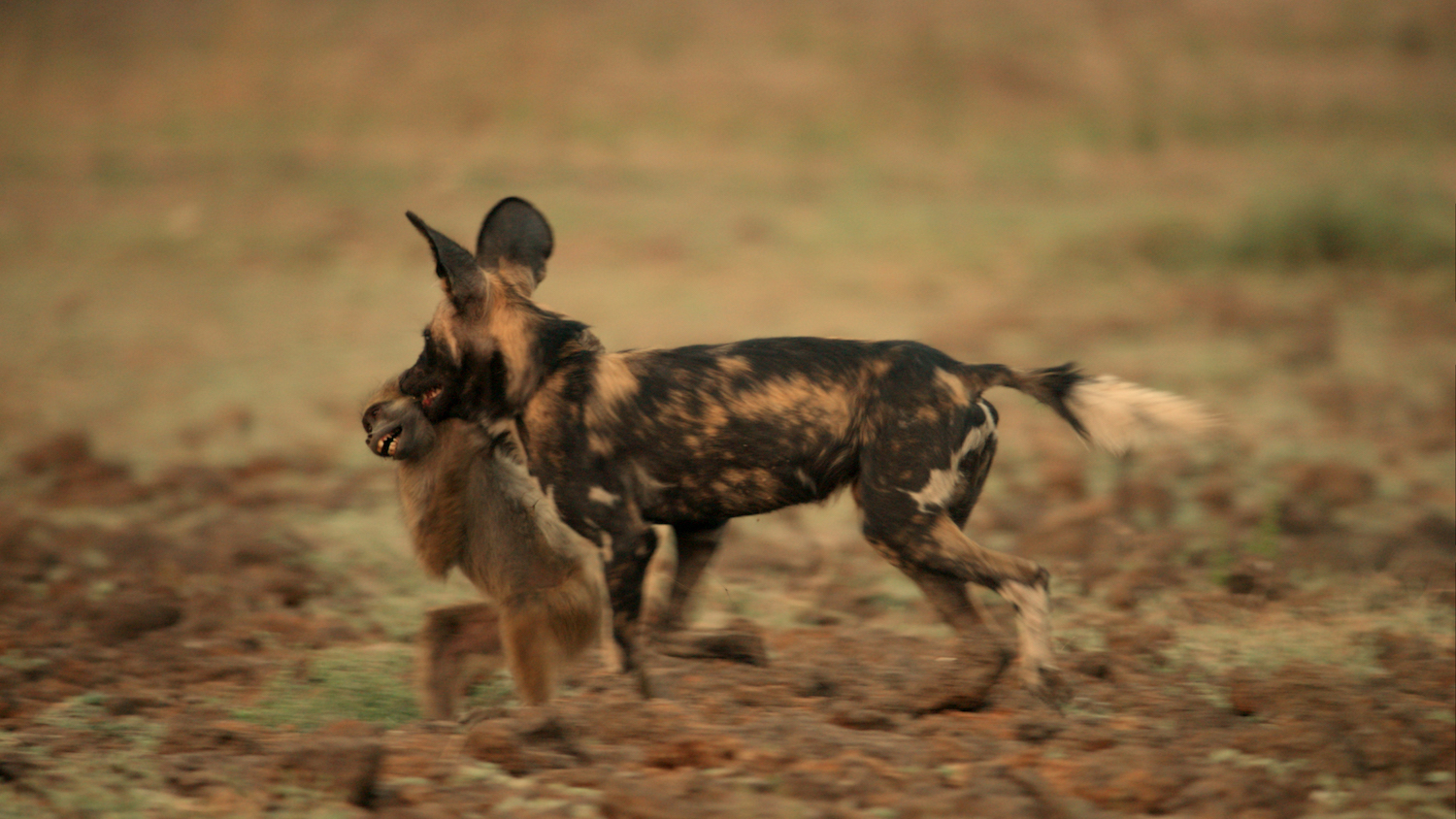Painted Wolves Caught on Camera Hunting Baboons for the First Time
Most predators in the animal kingdom know better than to go after prey that could seriously hurt them, but Africa's painted wolves don't seem too concerned about that. This week's episode of BBC America's "Dynasties" presents the first documented instance of painted wolves hunting and eating baboons — a primate species that's well-known for retaliating violently against its predators.
Painted wolves, also called African wild dogs (Lycaon pictus), are the underdogs of African carnivores. They grow up to 30 inches (75 centimeters) tall at the shoulder and weigh up to 55 lbs. (25 kilograms). And as seen in this intense "Dynasties" clip, painted wolves are easily pushed around by their much larger elephant neighbors. (Although, almost all animals will run from an angry elephant.)
Despite their gorgeous markings, adorably goofy-looking ears and charismatic behavior, these wild canines are poorly understood and are one of the world's most endangered mammals. There are only around 6,600 painted wolves in the wild and their numbers are decreasing, according to the World Wildlife Fund. [In Photos: The Majestic Painted Wolves of Zimbabwe]
Although they're modest in stature, painted wolves are masterful hunters capable of taking down swift and agile antelope and impala that are about twice their size.
Anecdotal evidence suggested that painted wolves may hunt baboons, too, but only rarely. In general, baboons are an undesirable prey species for most predators because the primates are capable of inflicting serious injury or death, with their sharp, 2-inch-long (5 cm) canine teeth.
But as scientists and the "Dynasties" film crew found out, the painted wolves in Mana Pools National Park in Zimbabwe are different.
The researchers and film crew followed two packs of painted wolves for nearly two years and documented more than 170 prey kills — the vast majority of which were impalas and baboons. After about a year of observations, the researchers noticed that both packs began to show a preference for baboons over the larger and more rewarding impala.
Sign up for the Live Science daily newsletter now
Get the world’s most fascinating discoveries delivered straight to your inbox.

The researchers suspected that the painted wolves changed their food preference because there are fewer circumstantial risks of going after a baboon versus an impala.
For example, extensive elephant movement across the floodplain during the wet season leaves large, deep footprints in the mud that, once dried, become hazardous obstacles for the painted wolves to sprint over when chasing impala at full speed.
Also important to consider are several other African carnivores that enjoy having impala on their menu, and wouldn't mind adding a side dish of painted wolf. Within the Mana Pools National Park, there are resident lions, hyenas, leopards and cheetahs — all are bigger and stronger than the painted wolves.
Compared to impala, baboons are relatively slow runners, so painted wolves don't have to chase a baboon far before catching it. But that doesn't mean baboons should be considered easy prey — they definitely know how to defend themselves. Photos from the researchers who were working with BBC published in the journal Behaviour and others from nature photographer Nick Lyon published in National Geographic, show painted wolves with some gruesome baboon-battle injuries.
Baboon hunting in these two particular wolf packs likely started with the original alpha female of one of the packs, around a decade ago, the researchers wrote. Both of the painted wolf packs the researchers studied include descendants of the baboon-hunting female. There are five other painted wolf packs in Mana Pools National Park, and a safari guide has reported seeing one of those packs feed on a baboon. This suggests that hunting baboons is a learned behavior that may eventually disseminate to other packs. Watch this week's episode of "Dynasties" to see these baboon hunters in action.
Narrated by Sir David Attenborough, BBC America's "Dynasties" gives viewers an up-close-and-personal look into the family lives of five of the most celebrated and endangered animals on the planet. The fourth episode, "Painted Wolf," premieres Saturday (Feb. 9) on BBC America at 9 p.m. EST/8 p.m. CST. Viewers can watch the first episode, "Lion," for free online.
- Look Quick: Gallery of the Fastest Beasts on Land
- In Photos: The Lions of Kenya's Masai Mara
- Top 10 Deadliest Animals (Photos)
Originally published on Live Science.

Kimberly has a bachelor's degree in marine biology from Texas A&M University, a master's degree in biology from Southeastern Louisiana University and a graduate certificate in science communication from the University of California, Santa Cruz. She is a former reference editor for Live Science and Space.com. Her work has appeared in Inside Science, News from Science, the San Jose Mercury and others. Her favorite stories include those about animals and obscurities. A Texas native, Kim now lives in a California redwood forest.









